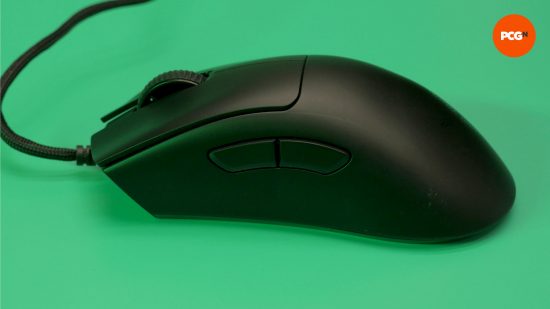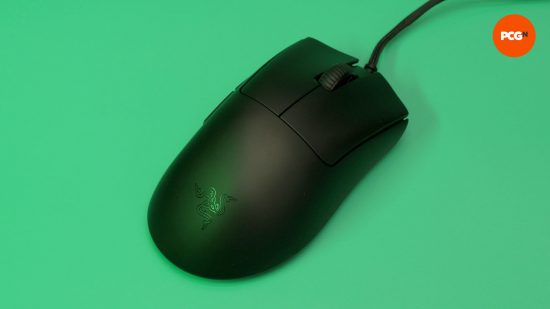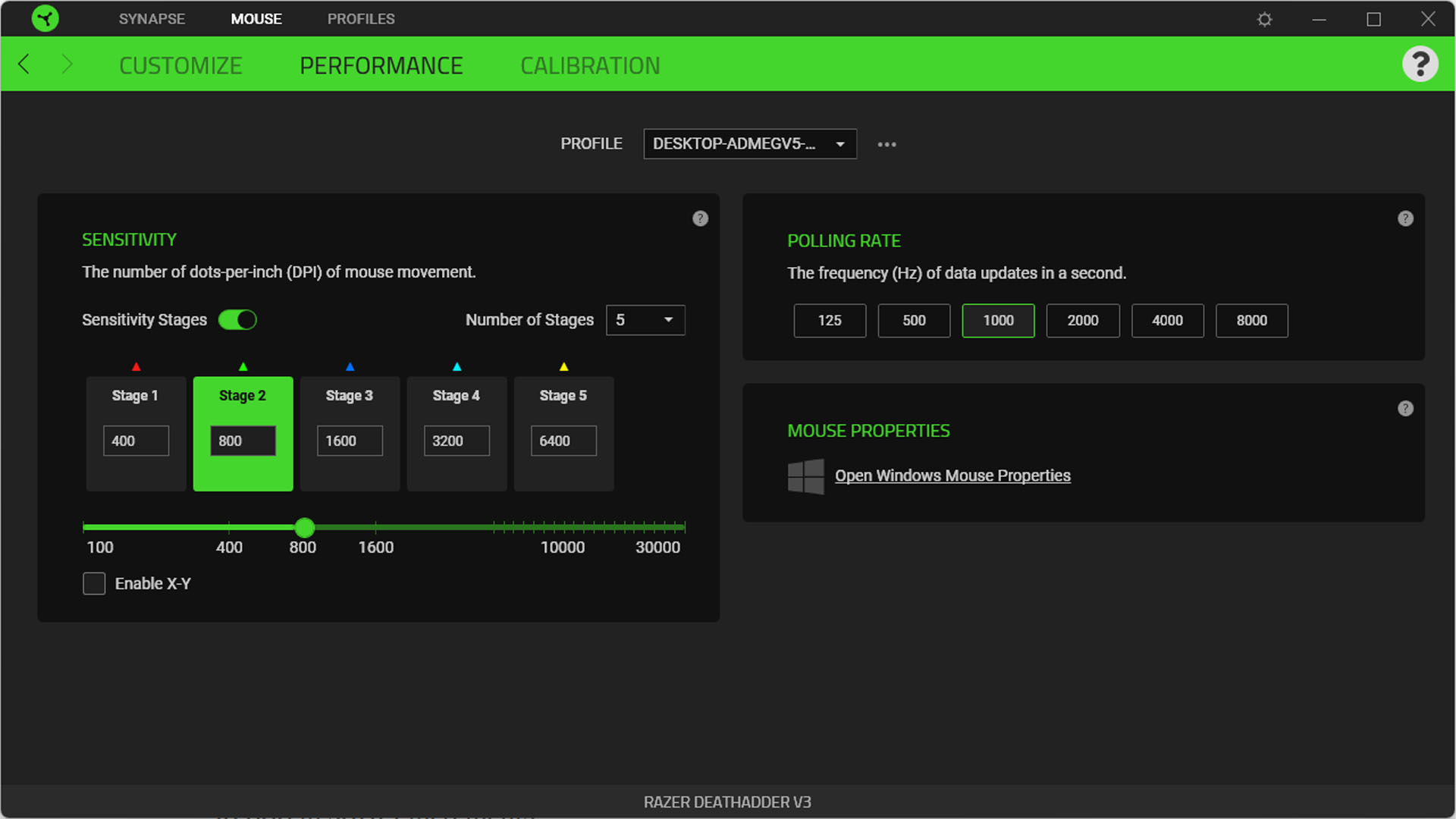Our Verdict
With a very light weight of just 59g, and an effortlessly simple but comfortable design, the DeathAdder V3 is a fantastic mouse to hold and use. Moreover, its 30K DPI sensor and up to 8kHz polling rate make it a mighty capable gaming mouse too. Its price is a little high, but it's still worth a look if you want the reliability of a wired connection.
- Very comfortable ergonomic shape
- Very light
- Fantastic gaming performance
- Basic feature set
- Undefined scroll wheel detents
- Mediocre value
The DeathAdder is one of the longest-running mouse designs in gaming mouse history, with its first iteration now approaching 20 years old. Its comfortable, ergonomic shape has simply stood the test of time. The Razer DeathAdder V3 is the latest version, and it keeps the design simple, with a basic tally of five buttons and a lightweight build, making it an ideal wired option for esports and more.
This Razer mouse’s pricier, wireless sibling, the DeathAdder V3 Pro is currently our premium choice for the best gaming mouse, so the simpler V3 has plenty to live up to. Largely it doesn’t disappoint, even if it doesn’t quite blow us away.
Why you can trust our advice ✔ At PCGamesN, our experts spend hours testing hardware and reviewing games and VPNs. We share honest, unbiased opinions to help you buy the best. Find out how we test.
Specs
| Sensor | Focus Pro 30K optical sensor |
| Buttons | 5 + 1 on underside |
| DPI | Up to 30,000 |
| Dimensions (mm) | 68 x 128 x 44 (W x D x H) |
| Weight | 59g |
| Connections | Wired: Razer Speedflex cable |
| Extras | Razer gen-3 optical switches (90M clicks) |
Features
The DeathAdder V3 really is a very basic gaming mouse. It’s wired, for a start, so there’s no Bluetooth support, or any concerns with dongles, battery life, and swapping connections that are factors with wireless options. It also has just five main buttons – left, right, middle (scroll wheel), and two side thumb buttons.

On the underside, there’s also a dedicated DPI-switching button, which by default cycles between five different settings but these can be reduced to as few as two settings using Razer’s software. Flipping over the mouse also reveals that the skates/pads/feet used here are plain white PTFE ones, with no extras supplied in the box. Indeed, you get no extras at all in the box.
A fixed cable sprouts from the front of the mouse – it would have been useful to have a removable cable, such as the one on the SteelSeries Aerox 3, but on the plus side, the DeathAdder has a lightweight, very flexible, braided cable that Razer calls Speedflex.
The sensor is also Razer branded as the Focus Pro 30K. It’s a conventional optical sensor with a maximum DPI of 30,000, and it can track movement at up to 750 inches per second (IPS) at an acceleration rate of 70G. That puts it in top-tier territory for overall tracking performance, in theory.

Meanwhile, the two main left and right buttons use Razer’s gen-3 optical switches. They have a click life rating of 90 million clicks, which is certainly on the higher end of the scale. The use of an optical signal also theoretically reduces any possible lag from needing to have a debounce delay for normal metal-on-metal switches.
Design
The core design of the DeathAdder V3 is largely the same as the last two decades of DeathAdders. It uses a traditional ‘ergonomic’ shape, which means it’s not symmetrical but instead has a slightly concave left side, a slightly convex right side, and a sloping profile going from a high left side to a lower right side. The right side is a bit less convex than the old V2 style and the front edges aren’t so flared – we prefer it, as it feels like a slightly more versatile design for varied hand sizes and grip styles.

Meanwhile, the overall ergonomic shape lends the mouse a relaxed feel when holding it in your fingers for a fingertip grip, or when draping your whole hand over it in a palm grip style. The sloping profile allows your hand to sit a little more upright, in line with the natural position of your wrist. Flatter, more symmetrical-style mice tend to require you to twist your wrist a little more to grip them.
It’s also relatively large, which means it suits palm grip style for small to medium-sized hands but can also be used comfortably in a fingertip grip if you have medium to large hands. I didn’t find it particularly suited to claw grip, though, as the sloped right edge didn’t provide enough grip.
Helping immensely whatever grip style you use is the very low 59g weight of this mouse. That doesn’t make it the lightest mouse ever – it would have to knock another 20g off to claim that title – but it still makes for a mouse that’s very easy to sling around your mat. Likewise, the lightweight cable provides minimal pushback against your movements.
In terms of styling, Razer’s usual flair for a sleek look is present, with this entirely black mouse managing to look stylishly minimalist rather than just basic – the glossy black Razer logo set against the matte of the rest of the mouse looks classy.

The finish is an apparently all-new matt soft-touch coating that adds just a very slightly soft, rubbery, grippy quality to the matte finish. It feels great, though thin soft-touch finishes do tend to wear off quite quickly so it will be interesting to see if this one lasts several years of gaming. Mice with thicker rubber pads on the sides tend to hold up much better in the long term.
Flip over this mouse and the combination of the white skates and big blank expanse in the middle of the mouse does make it look a touch cheap and basic, but it is after all the underside.
Perhaps the biggest missing feature here – other than much in the way of extra buttons – is RGB lighting. There is none. I will admit to quite liking the odd bit of integrated lighting on a mouse, but purely for the fun of it – it’s not a feature I miss in the heat of battle.

Performance
Starting with this mouse’s sensor performance, the Focus Pro 30K is as flawless in tracking tests as we’ve come to expect of modern gaming mice. It’s seldom that any mouse from any of the top names doesn’t deliver on this front, and sure enough, the DeathAdder V3 isn’t a letdown.
What’s more, this mouse offers the option to increase its polling rate from 1,000Hz to 8,000Hz, ensuring you get 8x the position updates from the mouse per second than a conventional mouse. In practice, this is only of benefit to those with very fast refresh rate monitors, as 1,000Hz is plenty of positional updates a second for 120Hz, and arguably even 240Hz displays.

Moreover, while I could just about feel the step up in smoothness and accuracy when going from 1,000Hz to 4,000Hz, cranking the polling rate all the way up to 8,000Hz caused stuttering in Apex Legends. Razer warns that the high polling rate does put a high load on the CPU, and this was our experience. As such, the 8kHz polling is certainly not a feature we’d consider essential.
As for the optical switches, these performed flawlessly, providing a crisp, no-latency response, again as we’d largely expect from a modern gaming mouse switch. The feel of these switches sits somewhere between the lighter, quieter response of Logitech’s switches but not quite as loud and tactile as some other options.
All told, the only factor that was a slight concern regarding the pure gaming performance of this mouse is its scroll wheel. The middle button click isn’t the most distinct, and the detents on the wheel are quite soft. As such, it doesn’t feel particularly precise for using to control feawtures such as switching weapons, for instance. It works but the feedback isn’t as marked as I’d like.
Razer software
Razer’s Synapse software can be used to adjust the default settings of this mouse. It’s not an essential download – though simply plugging in the mouse will fire up a prompt suggesting you should download it – but it’s useful for setting up your preferred DPI options and polling rate.

You can opt for between two and five DPI levels, ranging from 100-30,000 DPI in increments of 50. The polling rate, meanwhile, can be set to 125Hz, 500Hz, 1,000Hz, 2,000Hz, 4,000Hz, or 8,000Hz.

You can also set the lift-off distance of the mouse, which is how quickly it stops tracking when you pick up and adjust the position of your mouse. There are just three settings of low, medium, and high, which adjust the distance by around 1mm but you can also opt for asymmetrical lift off. This lets you have different settings for the point the mouse stops tracking (lift off) and the point it restarts again (landing). I didn’t really find this feature useful, but it’s a nice level of tweakability.

The only other setting here is the ability to program the buttons, with the usual huge selection of options, such as keyboard buttons, mouse functions, multimedia triggers, profile switching, and more. You can also assign a HyperShift button, which essentially acts like the Fn key on a keyboard, shifting the function of other buttons on the mouse to a secondary use.
Price
The Razer DeathAdder V3 price of $69.99 makes it just a little bit too expensive for the features it offers. Yes, it is particularly light and has an 8,000Hz polling rate, top sensor, and optical switches. However, plenty of other gaming mice offer the same core features of a quality sensor and five buttons for $20 less, and many include RGB lighting and other features. For instance, the Glorious Model D and Logitech G403 Hero are available for under $50. Meanwhile, Razer’s own Viper V3 HyperSpeed offers a wireless connection for the same price as this mouse, though it does require separate batteries.
Final verdict
We thoroughly approve of Razer’s no-frills approach to the design of the DeathAdder V3. It delivers fantastic performance in nearly all areas, with only the slightly indistinct detents on the scroll wheel being a complaint in terms of the usability of the mouse.
Its tracking is also flawless, while its design is comfortable, stylish, and very light. As such, it’s only really the slightly high price that lets it down. It doesn’t offer terrible value, but the raw feature set is really basic at this price. Many wireless options cost the same price, and wired alternatives are available for $10-$20 less.
Alternatives
Razer DeathAdder V3 Pro
If you like everything you see about the DeathAdder V3, but just can’t bear the idea of using a cable, the DeathAdder V3 Pro is the mouse to buy. It’s a touch heavier, at 64g, and is a lot more expensive, at $140, but it’s still a fantastic option.
Razer DeathAdder Essential
Yes, there are yet more variations of the DeathAdder. The DeathAdder Essential keeps roughly the same shape as its more expensive siblings but switches up its innards for a more basic sensor and switches. It’s still a solid performer, with decent tracking and responsiveness. It’s a bit heavy, at 96g, but that’s why it costs just $25.
